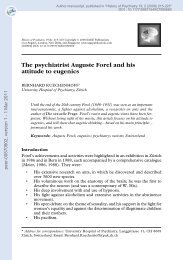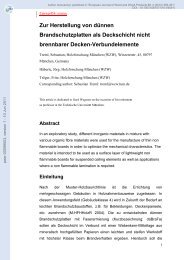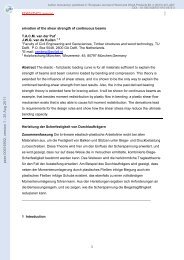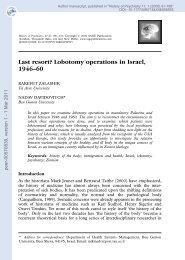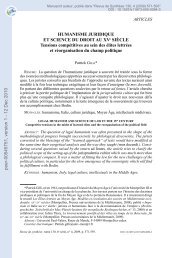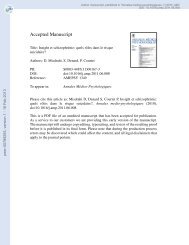Cosheaves and connectedness in formal topology
Cosheaves and connectedness in formal topology
Cosheaves and connectedness in formal topology
Create successful ePaper yourself
Turn your PDF publications into a flip-book with our unique Google optimized e-Paper software.
peer-00821313, version 1 - 9 May 2013<br />
a ′ ≤ γ a. S<strong>in</strong>ce a ′ ⊳ s − (a, γ) ↓ s − V ⊳ s − ((a, γ) ↓ V ), <strong>and</strong> a ′ is positive,<br />
(a, γ) ↓ V is <strong>in</strong>habited.<br />
Now suppose that (b i , δ i ) ∈ (a, γ) ↓ V (i = 1, 2); we must show that (b 1 , δ 1 ) ∼<br />
(b 2 , δ 2 ). We can f<strong>in</strong>d (b ′ i , δ′ i ) ≤ (b i, δ i ) with b ′ i ≤δi b i so that b ′ i ≤γ a; also,<br />
(b i , δ i ) ∼ (b ′ i , δ′ i ). Hence without loss of generality we can assume b i ∈ s − ((a, γ) ↓<br />
V ). S<strong>in</strong>ce a ⊳ ⋃ {≤ α a | α ∈ π 0 (a)}, there is a connection from (b 1 , δ 1 ) to<br />
(b 2 , δ 2 ) <strong>in</strong> ⋃ {≤ α a | α ∈ π 0 (a)}. If we have (c 1 , ε 1 ) ≤ (c 2 , ε 2 ) with c i ≤ αi a then<br />
α 1 = (π 0 ) c1,a(ε 1 ) = (π 0 ) c2,a(ε 2 ) = α 2 , <strong>and</strong> it follows that the connection from<br />
(b 1 , δ 1 ) to (b 2 , δ 2 ) must be <strong>in</strong> ≤ γ a. If (c, ε) is an element of the connection, then<br />
because (≤ γ a) ⊳ s − V we can f<strong>in</strong>d (c ′ , ε ′ ) ≤ (c, ε) with c ′ ∈ s − V . Suppose now<br />
we have (c 1 , ε 1 ) ≤ (c 2 , ε 2 ) as a l<strong>in</strong>k <strong>in</strong> the connection from (b 1 , δ 1 ) to (b 2 , δ 2 ).<br />
Then there is a connection from (c ′ 1, ε ′ 1) to (c ′ 2, ε ′ 2) <strong>in</strong> c 2 ↓ s − V ⊆ s − ((a, γ) ↓ V )<br />
<strong>and</strong> so (c ′ 1, ε ′ 1) ∼ (c ′ 2, ε ′ 2). Putt<strong>in</strong>g these together, <strong>and</strong> remember<strong>in</strong>g that (b 1 , δ 1 )<br />
<strong>and</strong> (b 2 , δ 2 ) are already <strong>in</strong> (a, γ) ↓ V , we f<strong>in</strong>d (b 1 , δ 1 ) ∼ (b 2 , δ 2 ).<br />
This completes the proof of part (1). For part (4), s<strong>in</strong>ce π 0 ′ is a term<strong>in</strong>al<br />
cosheaf for Y , <strong>and</strong> p is a homeomorphism, Cosh p(π 0) ′ is a term<strong>in</strong>al cosheaf for<br />
X.<br />
In Proposition 31 we shall see the above construction of ( ∑ a∈P π 0(a), ≤, ⊳)<br />
<strong>and</strong> p as a special example of the “complete spread” construction (for cosheaves<br />
other than π 0 ), which can be described more generally <strong>in</strong> the <strong>in</strong>ductively generated<br />
case.<br />
Theorem 24. A <strong>formal</strong> <strong>topology</strong> is locally connected iff it is homeomorphic to<br />
a <strong>formal</strong>ly locally connected <strong>formal</strong> <strong>topology</strong>.<br />
Proof. The ⇒ direction is Proposition 23. The ⇐ direction comes from Corollary<br />
22.<br />
We shall next show how to f<strong>in</strong>d connected components for arbitrary opens<br />
<strong>in</strong> a locally connected <strong>formal</strong> <strong>topology</strong>.<br />
Def<strong>in</strong>ition 25. Let X = (P, ≤, ⊳) be locally connected, <strong>and</strong> suppose A ⊆ P<br />
<strong>and</strong> γ ∈ π 0 (A) = colim a∈↓A π 0 (a). Def<strong>in</strong>e<br />
≤ γ A = ⋃ {≤ δ a | γ = <strong>in</strong> a (δ)}.<br />
Proposition 26. Let X = (P, ≤, ⊳) be locally connected, <strong>and</strong> suppose A ⊆ P .<br />
1. A ⊳ ⋃ γ∈π 0(A) (≤γ A).<br />
2. The opens ≤ γ A (γ ∈ π 0 (A)) are pairwise disjo<strong>in</strong>t.<br />
3. Each ≤ γ A is connected.<br />
Proof. (1) This follows from the fact that a ⊳ ⋃ γ∈π 0(a) ≤γ a.<br />
(2) Suppose b ∈ (≤ γ1 A) ↓ (≤ γ2 A). Then b ≤ δi a i with <strong>in</strong> ai (δ i ) = γ i . If<br />
ε ∈ π 0 (b) then (b, ε) ≤ (a i , δ i ) (i = 1, 2) so γ i = <strong>in</strong> b (ε) <strong>and</strong> γ 1 = γ 2 . Hence<br />
(≤ γ1 A) ↓ (≤ γ2 A) ⊳ {d ∈ P | γ 1 = γ 2 }.<br />
18



